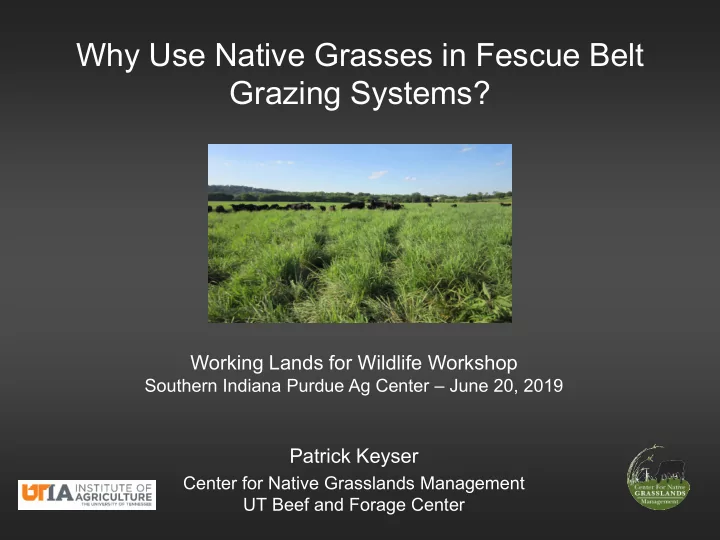

Why Use Native Grasses in Fescue Belt Grazing Systems? Working Lands for Wildlife Workshop Southern Indiana Purdue Ag Center – June 20, 2019 Patrick Keyser Center for Native Grasslands Management UT Beef and Forage Center
Putting It in Perspective: Improved Summer Forage Production
Repeated Severe Droughts Five out of ten years have been extreme or 2007 exceptional droughts in major parts of the TFB… 2008 2012 2016 2011 32,000 lost operations, 2007-2012 alone!
Decadal Oscillation – Why Do They Just Keep Coming? Atlantic Brian Bledsoe, Southern Livestock Standard Meteorologist. Presentation at the 71 st Southern Pasture and Forage Crop Improvement Pacific Conference Knoxville, TN, June 5, 2017.
Drought… The Gift that Keeps on Giving! Jessamine Co, KY Aug 2008
What About the Bottom Line? NCBA’s Standard Performance Analysis Data from 475 herds over 15 years 25 24 23 Acres per Cow 22 21 20 19 18 17 16 15 Top 25% 2nd 25% 3rd 25% Low Performance Quartile Acres per Cow Courtesy, Dr. Jason Johnson, Texas A&M Extension Ag Econ
The Bottom Line… Data from 475 herds over 15 years 25 8.00% 6.60% 24 6.00% 23 4.00% Return on Assets Acres per Cow 22 2.00% 2.30% 21 0.00% 20 -2.00% -2.00% 19 -4.00% 18 -6.00% 17 -7.40% -8.00% 16 15 -10.00% Top 25% 2nd 25% 3rd 25% Low Performance Quartile Acres per Cow % ROA Courtesy, Dr. Jason Johnson, Texas A&M Extension Ag Econ
Summer Forage Slump Reduced: • quantity • quality • intake • performance • pasture damage Even without these droughts, we should complement CSG-dominated systems with WSG
Fescue Toxicosis Well-documented penalty during summer, reduced: - calving rate (92% vs. <70%) - weaning weight (570# vs. 525#) - ADG (1.2 vs. 0.8 lb/day for steers )
Interest in Improving Summer Forage (In April, After Average to Wet Summer, 2010) 1,620 TN beef producers (20-499 head; 80% of TN farms); Margin of error = 1.81% 35 30 Respondents (%) 25 31% 20 22% 15 10 5 0 Not Somewhat Interested Very P. Keyser, Univ. TN, unpublished data
Are Native Grasses a Viable Option?
Going “Old School” What Was here, “Back in the Day”? 45⁰ N 38⁰ 27’ N C 4 = warm-season grasses C 3 = cool-season grasses Tieszen et al. 1997. Ecol. Applic.
What Would an Ideal Summer Forage Look Like? Ideally, summer forages should offer: – Exceptional drought resiliency – High yields – Strong animal performance – Long stand life (perennials) – Cost-effective production – No toxins
C 4 Photosynthesis = Green Grass July 12, 2018, Linn Co., MO; D2/D3 Drought
Exceptional Drought Tolerance 12 Dry Matter Yield (T/ac) 65% of 4-year average 10 8 6 4 2 0 2006 2007 2008 2009 Courtesy Dr. Don Tyler, Univ. TN
Deep Roots = Soil Health
Soil Health: Improved Water Infiltration Hydraulic Conductivity (Kfs cm/s) 0.006 0.005 0.004 0.003 0.002 ab a bc c 0.001 0 Bigblue Alamo Gama Fescue Less: erosion, runoff, nutrient loss More: water stored within the soil
High Yields Gene Olson et al. 2009. University of Kentucky Extension TN preliminary (3-yr) yields: 5.6 T/ac for BB, 4.4 T/ac for IG
Animal Performance (Steers) 2010-2012 ADG Gain Forage (lb/hd) (lb/ac) Switchgrass 1.74 435 Big blue/Indian 2.11 368 Eastern gamagrass 1.06 247 93 – 115 days grazing per year ; 600 lb starting wt Backus et al., 2017 Journal of Animal Science, 95:3143-3153
Long-lived Perennial... • 21-year old stand of switchgrass • managed with: – no fertilizer – no spraying July 19, 3 PM, 90⁰ – rotational grazing – spring fire (every 1-3 yrs)
Cost of Gain ($ per lb) for Grazing Heifers Heifer development: - most expensive aspect of production - mainly feed cost (75%) for 30+ months w/o any return $0.50 $0.40 $0.30 $0.20 $0.10 $0.00 Big Switchgrass bluestem/indiangrass Keyser et al. 2016. Agronomy Journal 108:373–383
Spring-Calving Herd Cow Pregnancy Rates With and Without Non-toxic Summer Forage 100 Weaning Weights 90 80 -32.7% -31 lb (steer & heifer) 70 60 50 40 30 20 10 0 E+E+ E+Other OtherOther M. Burns, Clemson Univ., PhD dissertation, 2012.
What Would an Ideal Summer Forage Look Like? Ideally, summer forages should offer: – Exceptional drought resiliency – High yields – Strong animal performance – Long stand life (perennials) – Cost-effective production – No toxins
Complementing Cool-season System with Warm-season Grasses = Improved: Orange Co., NC, June 10, 2014 – condition of CSG pastures (rest) – besides clovers, best thing we can do to improve fescue management? – opportunities for stockpiling – reduced hay feeding costs/improved profitability? – resilience to fescue toxicosis (increased pregnancy retention, birth/weaning weights)
Complementing Cool-season System with Warm-season Grasses = Improved: Orange Co., NC, June 10, 2014 – backgrounding retained steers (fall calving herds) – heifer development (post-weaning and post-breeding) – drought resiliency for cows Still need data on impacts to repro side (spring and fall calving herds): – improved calving rates? – improved weaning weights?
Native Grass College http://nativegrasses.utk.edu/curricula.htm
Questions?
Recommend
More recommend